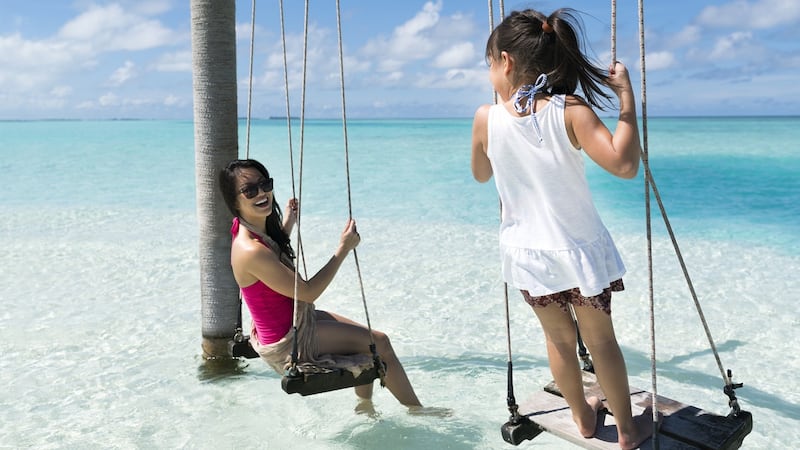Say koba kae, Maldivian for a casual hello, to the Indian Ocean’s pearliest white islands, a destination that escapes the everyday, where a high-end resort holiday offers a multitude of memory-making must-dos, ideal for the easily bored.
Already one of the world's top couples retreats, the Maldives – the super-luxurious Indian Ocean destination – also makes for a very special family get-away.
Stretching 130km across the Indian Ocean and extending from just below the equator through 860km of atolls and fushis, the Maldives is a country where less than ½ per cent of its total territory is land – it’s made up of more than a thousand islands, surrounded by a water mass that makes up more than 99 per cent of the country.


Washed by the Arabian Sea and the warm waters of the Indian Ocean, there are not enough superlatives in the English language to conjure up its compelling offer: jewel-coloured waters of opaline, aquamarine and turquoise, pearl white coral sands and a temperature that rarely dips below 27ºC.
Impossibly Instragrammable, the place is picture-perfect and with most of its tourism built around resorts, it is also incredibly safe. This is what makes it such a compelling family destination, especially those with kids under the age of 12 – for while much has been written on what a romantic destination the country is, its blissfully private resorts designed to create a sense of seclusion where privacy is paramount, these attributes also work for time-poor parents looking for a way to spend some quality beach time with the their juniors.
Shoulder season and low season are canny times to come and enjoy the experience. The temperatures are still balmy, there’s a bit of an offshore breeze keeping things temperate and you will have rain, but nothing like Irish rain. This stuff is soft and warm. It can last minutes or hours but oftentimes the latter happens at night. Either way, it is warm enough to swim in, even in cold-water pools, and means you wake up to the lush vegetation, frangipani, hibiscus and orchids, as well as all manner of palms, planted to enhance the vista and provide shade and shelter.
Barefoot and private
The resorts too are less crowded – although the holiday offer here is designed to feel as barefoot and private as possible at any time of the year – in low season occupancy is at 60 per cent, meaning there are early mornings when you can have a beach to yourself.
Anatara is a resort group that remains somewhat under the radar to Irish travellers. While it has hosted tech scions and sports and music celebrities, it wears its luxury offering lightly, and will appeal to those for whom the word resort brings them out in a rash. The staff here won't ever look down snootily at your attire or luggage choices. Rather, they'll remember how you like your coffee or eggs in the morning so you don't ever have to ask twice. The accommodation is in over-water villas, beach houses and ocean-view villas with decks.
Water babies will love the fact that the islands boast some of the world’s best marine life – where sightings of stingrays, sharks, sea turtles, moray eels and mantas, an aquatic version of Africa’s big five, are almost commonplace; and every tropical fish you ever saw in a tank will make an appearance, around jetties and shallow lagoons as well as in deep-water channels. One of the simplest ways to meet some of these residents is to take a snorkel mask and a set of fins and hit the water. A bit of pre-holiday research into the more common species will make the sightings even more special.
A snorkel excursion out beyond the reefs may deliver encounters with dolphins, sea turtles or manta rays. Out here, the fish sit in tiers that are at different depths and the visibility is remarkable. You could almost bring a shopping bag and select lunch. They all seem busy, eating or being eaten and swishing along the fish superhighways. A highlight was a sighting of a sea turtle, loudly breaking off bites of coral about 10m down. Without a guide to point it, out it would have been completely missed.
The place is beautiful but is not quite as au naturel as it first appears – some of the boat channels have to dredged every year as they get choked by sand; these are marked by their intense marine-blue colour. The sandy shoreline is replenished every morning, and the islands’ original palms and shrubbery have been filled out with temple flowers, frangipani, hibiscus and orchids to bring colour and fragrance into the mix. Staff brush fallen leaves from the sandy paths that weave their way through the islands and do the same at tide levels. The grounds are even fumigated to minimise the mosquito nuisance, a rather thoughtful intervention,
Local flavour
But there is some local flavour. Squatting under the decks and coral jetties you’ll see sunworshipping crabs as loyal to their patch as the vacationer that rises at dawn to claim a particular deck lounger with his towel.
Whole colonies of hermit crabs have set up home on the foreshore, a micro detail that will delight small kids and only visible if you stare at the sun-bleached shells that are strewn along the beach for long enough. Many will be on the move, and the des residences come in every size from miniscule to mcmansion. One, backlit by deck lighting, seemed, well, the size of a house.
From the deck of your villa on Dhigu, the family island, you might spy a stingray racing against the reef’s ebbing tide. In the same villas, there is a viewing pane of glass set into the limestone floor so that while you’re sitting on the loo you can look down and see juvenile black-tipped sharks. You might see humbugs dining on coral, wearing stripes just like the sweets, or catch a glimpse of a moray eel snaking past.
In parts of the resort, the only sound you’ll hear is the surf fizzing as it hits the coral, occasionally punctuated by the hum of the diesel engines of the dhoni, a wooden ferry transporting workers to and from the capital, and the early morning fishing boats that hunt in packs to encircle the shoals of yellow fin tuna common to the waters. Overhead, there is the odd hum of a seaplane.
Unless you go to one of the local islands, the only real Maldivian culture you will see are souvenirs in the gift shop. There is little of the the fine coral carvings of country’s many mosques nor will you see any of the women wearing the traditional embroidered dress, ‘Dhivehi libaas’, but where the resort comes up trumps is in the cuisine, where you can sample a fine Maldivian curry – made using cumin, cardamom, turmeric, banana leaf, curry powder and coconut milk, served with chapati – for breakfast.
Here the cuisine fuses Moorish, Keralan, India’s southern state, and Sri Lankan influences and you can also take a cooking class where you can learn to make said curry and bring home the recipe as a souvenir that will recall your visit long after your tan has faded.
The decor is Asian in influence with lots of teak used in the roof and beams with mahogany flooring underfoot indoors and soft sand and smooth sandstone and bleached timber decking outside. Much of the accommodation has weathered thatch roofing.
Offshore is Maafishu, a local island, where you can see small high rises mid-construction for an altogether less upmarket kind of tourism. It is one of the many islands where you can stay in guest houses, a trend that sees an increasing umber of backpacks on the carousel at Malé airport.
You could spend a morning collecting coral and shells, any amount of time snorkelling, you can also do a day’s dive, although the kids won’t be able to join you. You can kayak, with one or two to a boat. It’s a gorgeous way to explore at low tide. You can also paddleboard. Kitesurfing, windsurfing or reefsurfing are other options, although you’ll need about four lessons to really get a handle on kiting.
There’s a kids’ club for little ones – giving adults time to indulge in a spa treatment at one of the resort’s several temples. These use Elemis products but have recently also introduced their own range, which includes very a thirst-quenching after-sun treatment ideal for pale Irish skin. You will also need to slather on a high-factor sunscreen as the burn factor here, especially out in the water, is high.
Alanna Gallagher was a guest of the Anatara Resort Group
Getting there
Getting there is relatively effortless. Although it takes two flights, you can fly Emirates direct from Dublin to Dubai, a travel time of about seven hours and from the same terminal catch a connecting flight to Malé with the same airline, a journey of about 4½ hours. The Anatara resorts are a short 30-minute speedboat ride from the airport.
Anatara.com/en/; Emirates.com
Staying there
A seven-night stay at a sunrise beach villa, Anantara Dhigu, Maldives, on a half-board basis, for a family of two adults and two kids under 12, departing September 13th costs from €6,659, and includes economy flights with Emirates from Dublin to Malé via Dubai and a speedboat transfer through Classic Resorts (ref 70891). A 10-night stay, departing September 12th, costs €8,399 (ref 70996). A 10-night stay over Christmas, departing December 20th, costs from €15,999 (ref 70894).
Classicresorts.ie
Eat
The local Maldivian curry, served at breakfast, with chapati, just part of a hugely diverse spread that will tickle every tastebud.
Visit
The highlight here is the marine life. Take a pair of fins and a snorkel mask and explore the wonders of the ocean.












